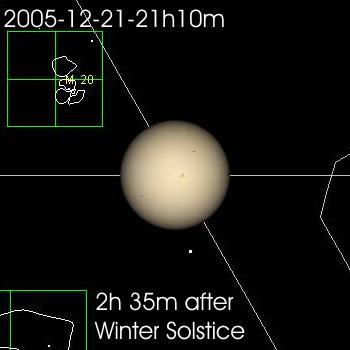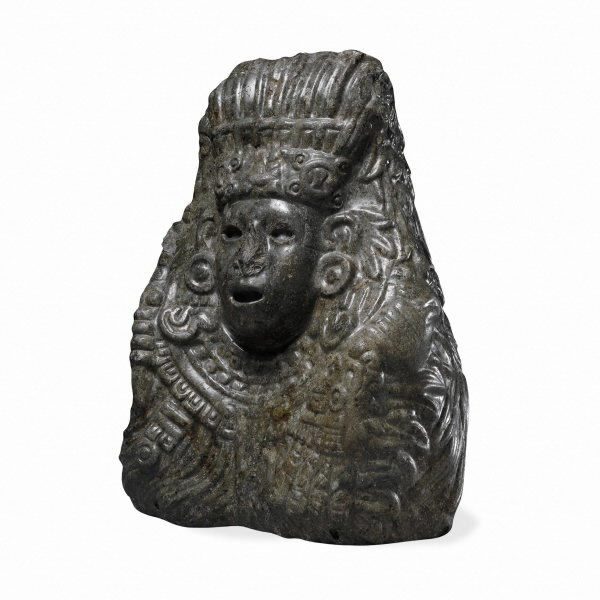Maya Galactic Alignment 2012 [21 Dec 2012]
Definition: [Astrological Ages] The idea that the current 'age' of the Mayan 'Long Count' calendar was designed by them to end on 21-Dec-2012 because that is the date of a Winter Solstice alignment of the Sun and the Galaxy. This idea was first promoted by John Major Jenkins in his book Maya Cosmogenesis 2012 [published in 1998]. The steps of the argument appear to be as follows:
1: The Maya used what is now called
a 'Long Count' calendar, of which the current longest cycle is dated to end on
the 21 December 2012.
2: The Maya particularly picked an end date of this
cycle [rather than a start date] because they had calculated that on that date
the Sun would be in the 'exact center of the Milky Way, the Galactic Equator'
[1]. In Mayan thought this 'dark cleft of the Milky Way' [1] had particular
mythical significance.
3: In order to set this end date the Maya must have
been able to calculate very exactly the Precession of the Equinoxes, because it is
this phenomenon which appears to move the Winter Solstice Sun around the
Ecliptic to be in the
significant place in 2012.
I am not qualified to comment on arguments (1) and (2). However, as to argument (3) Mr Jenkins notes that 'The Maya are not generally credited with knowing about the Precession of the Equinoxes' [1]. And indeed we have absolutely no evidence that the Maya knew anything about Precession.
However, we can at least look at the described 2012 alignment in two ways: (a) Is there in fact a Galactic Equator alignment of the Sun at Winter Solstice in 2012, and (b) if there is, is this something we should find significant?
|
Is there an Alignment between the Galactic Equator and the Sun at Winter Solstice 2012?: No. In fact there is an alignment between the Sun and the Galactic Equator at the time of Winter Solstice, but it has already happened. It happened back in 1997 [21st December 1997 AD 14h 43m GMT]. So, if the Maya did go through the sequence of the argument given above, their astrological predictions were out by some 15 years. [Which actually would be pretty good, seeing as they didn't have computers or astrological software to help them.] So the good news is if you were in any way worried about what might astrologically happen in 2012, don't worry: it already happened back in 1997. [Note: the Sun never aligns with the Galactic Center itself, because the Sun's path through the heavens, as seen from Earth [the Ecliptic] lies more than 5° above the Galactic Center. This is something that Mr Jenkins himself has pointed out, but the fact has become garbled in subsequent coverage of his ideas.] |

Winter Solstice Animation 1992 - 2020. How to understand the Star Map: The line which goes top left to bottom right is the Galactic Equator. The Sun starts slightly to the left of the Equator at the time of Winter Solstice in 1992 and at Winter Solstice 1997 reaches alignment. By 2012 it's 15 years past alignment, and the disc of the Sun moves completely off the Galactic Equator by 2020. [The horizontal line is the Ecliptic and the other features are nebula which lie in this area of the Milky Way]. [Warning this animation is some 400 kB in size.] |
|
Should we Consider an Alignment between the Galactic Equator and the Sun to be Significant?: It seems very unlikely. The Sun's movement through space, as seen from our view point here on Earth, passes across the Galactic Equator once a year. So from our viewpoint this alignment happens every year. [See the 2005 example on the right.] The only thing that's different about the 1997 coincidence of the Sun - as seen from Earth - and the Galactic Equator is that it happens at a particular time, the time of the Winter Solstice. Why should this be significant? Well.. there is no very good reason. The Maya may [or may not - again I am not qualified to comment on this] have found the Winter Solstice significant, as it marks the Sun's lowest top point in the daytime sky each year as seen from Earth. [Think of how the Sun never seems to get high in the sky in Winter.] But now we know that the Sun's movement in this way is just an optical illusion. It's caused by the tilt of the Earth's axis, with respect to the Ecliptic. Why would an optical illusion of the Sun's movement have any significance? Answer: no reason at all. |

Sun Alignment with the Galactic Equator in 2005. The Sun can be seen from the viewpoint of Earth to align with the Galactic Equator once every year. The particular example above is for 21 Dec 2005, 21 h 19 m UT. [Winter Solstice times in this and the above figure taken from Planetary and Lunar Coordinates 2000-2020, HM Nautical Almanac Office, and from US Naval Observatory Astronomical Applications Department information.] |
Other Maya 'Ages': A number of other authors have published books which contain other end dates, and/or calendars, for the current or recent Maya cycles. However, none of them seem to claim a specific astrological connection, so I'll mention them only very briefly here:
Carl Johan Calleman: in Mayan Calendar: Solving the Greatest Mystery of Our Time [published 2001], gives a date for the end of the current longest cycle of the Maya calendar as 28 October 2011, based on 'the correct tzolkin count and a corrected ending date.' [2] Dr Calleman and Mr Jenkins have had a long and public disagreement on their subject of their two differing ideas [2]. Dr Calleman has published a more recent book, The Mayan Calendar and the Transformation of Consciousness [published 2004], with a forward by Mr Argüelles.
Jose Argüelles: in The Mayan Factor: Path Beyond Technology [published 1987], produced a version of the Maya calendar, called the Dreamspell. Dr Calleman reports that Mr Jenkins 'exposed the calendar proposed by Jose Argüelles, the Dreamspell, as a calendar that had never been used by the Maya,' in the 'so-called true count debate that was posted on the Internet in 1995.' [2]
I can't refrain from commenting on this one... The idea behind Mr Shearer's work seems to be that the Maya god Quetzalcoatl is supposed to have prophesied his own return. After which there would be nine calendar cycles - which are supposed to have now ended. The later Aztecs mistook Cortez for the returning Quetzalcoatl, which Mr Shearer took as providing the start date for these nine cycles.
Er... yes, but surely the important point is that the Aztecs mistook Cortez for Quetzalcoatl - a mistake which Cortez was able to use to great advantage. Quetzalcoatl did not in fact return, and has in fact not returned... Doesn't this rather destroy the argument for a 'Harmonic Convergence'?
[1] http://www.levity.com/eschaton/Why2012.html.
Originally published in the Dec-Jan '95 issue of Mountain Astrologer.
[2]
http://www.diagnosis2012.co.uk. See the discussion between Dr Calleman and Mr
Jenkins.
[3] http://www.thewildrose.net/harmonic_convergence.html.
P.S. Does the Age of Aquarius Begin in 2012:
No.
Because of the current concentration on 2012 AD, there's been some confusion between this and the Age of Aquarius start year. The Age of Aquarius begins in about 2600 AD. From the archeological evidence we can safely say that the Maya never used Greek constellations in their view of the heavens; so it's not possible that they could have had an Age of Aquarius concept.
Publishing and Precession after Jung...
| 6: | Publishing and Precession after Jung... |
| 6a: | Ancient Egypt and Precession |
| 6b: | Ancient Babylonia and Precession |
| 6c: | Mithraism and Precession |
| 6d: | 2012 and the Maya Calendar |
© Dr Shepherd Simpson, Astrological Historian
Historical Astrology
See the new Astrological Index for the meaning of other astrological words and phrases
